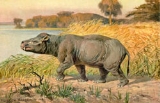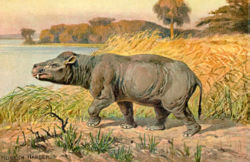
Coryphodon
Encyclopedia
Coryphodon is an extinct genus
of mammal
. It was widespread in North America between 59 and 51 million years ago. It is regarded as the ancestor of the genus Hypercoryphodon
of Mid Eocene
Mongolia
.
 Coryphodon was a pantodont, a member of the world's first group of large browsing mammals. It migrated across what is now northern North America, replacing Barylambda
Coryphodon was a pantodont, a member of the world's first group of large browsing mammals. It migrated across what is now northern North America, replacing Barylambda
, an earlier pantodont. At about 1 metres (3.3 ft) at shoulder height and 2.25 metres (7.4 ft) in body length, Coryphodon was the biggest known mammal of its time. It had a semi-aquatic lifestyle, likely living in swamps and marshes like a hippopotamus
, although it was not closely related to modern hippos or any other animal known today.
Fossils found on Ellesmere Island
, near Greenland, show that Coryphodon once lived there in warm swamp forests of huge trees, similar to the modern cypress swamps of the American South. Though the climate of the Eocene
was much warmer than today, plants and animals living north of the Arctic Circle
still experienced months of complete darkness and 24-hour summer days. Chemical studies of fossil bone show that in the summer, Coryphodon ate flowers, leaves, and swamp plants. In the winter dark, they survived on pine needles, dead leaves, and fungi. This flexible diet allowed the species to spread widely across the Eocene world.
Coryphodon had very strong neck muscles and short tusks that were probably used to uproot swamp plants. As in most pantodonts, the tusks were larger in males. The creature was very slow, with long upper limbs and short lower limbs, which were needed to support its weight. Coryphodon had one of the smallest brain/body ratios of any mammal, living or extinct, possessing a brain weighing just 90 grams (3.2 oz) and a body weight of around 500 kilograms (1,102.3 lb).
Genus
In biology, a genus is a low-level taxonomic rank used in the biological classification of living and fossil organisms, which is an example of definition by genus and differentia...
of mammal
Mammal
Mammals are members of a class of air-breathing vertebrate animals characterised by the possession of endothermy, hair, three middle ear bones, and mammary glands functional in mothers with young...
. It was widespread in North America between 59 and 51 million years ago. It is regarded as the ancestor of the genus Hypercoryphodon
Hypercoryphodon
Hypercoryphodon was a genus of rhinoceros-sized pantodont native to Middle Eocene Mongolia, and was very similar to its ancestor, Coryphodon....
of Mid Eocene
Eocene
The Eocene Epoch, lasting from about 56 to 34 million years ago , is a major division of the geologic timescale and the second epoch of the Paleogene Period in the Cenozoic Era. The Eocene spans the time from the end of the Palaeocene Epoch to the beginning of the Oligocene Epoch. The start of the...
Mongolia
Mongolia
Mongolia is a landlocked country in East and Central Asia. It is bordered by Russia to the north and China to the south, east and west. Although Mongolia does not share a border with Kazakhstan, its western-most point is only from Kazakhstan's eastern tip. Ulan Bator, the capital and largest...
.

Barylambda
Barylambda is an extinct genus of pantodont mammal from the middle to late Paleocene, well known from several finds in North America. Like other pantodonts, Barylambda was a heavyset, 5-toed plantigrade. Three species of Barylambda are currently recognised...
, an earlier pantodont. At about 1 metres (3.3 ft) at shoulder height and 2.25 metres (7.4 ft) in body length, Coryphodon was the biggest known mammal of its time. It had a semi-aquatic lifestyle, likely living in swamps and marshes like a hippopotamus
Hippopotamus
The hippopotamus , or hippo, from the ancient Greek for "river horse" , is a large, mostly herbivorous mammal in sub-Saharan Africa, and one of only two extant species in the family Hippopotamidae After the elephant and rhinoceros, the hippopotamus is the third largest land mammal and the heaviest...
, although it was not closely related to modern hippos or any other animal known today.
Fossils found on Ellesmere Island
Ellesmere Island
Ellesmere Island is part of the Qikiqtaaluk Region of the Canadian territory of Nunavut. Lying within the Canadian Arctic Archipelago, it is considered part of the Queen Elizabeth Islands, with Cape Columbia being the most northerly point of land in Canada...
, near Greenland, show that Coryphodon once lived there in warm swamp forests of huge trees, similar to the modern cypress swamps of the American South. Though the climate of the Eocene
Eocene
The Eocene Epoch, lasting from about 56 to 34 million years ago , is a major division of the geologic timescale and the second epoch of the Paleogene Period in the Cenozoic Era. The Eocene spans the time from the end of the Palaeocene Epoch to the beginning of the Oligocene Epoch. The start of the...
was much warmer than today, plants and animals living north of the Arctic Circle
Arctic Circle
The Arctic Circle is one of the five major circles of latitude that mark maps of the Earth. For Epoch 2011, it is the parallel of latitude that runs north of the Equator....
still experienced months of complete darkness and 24-hour summer days. Chemical studies of fossil bone show that in the summer, Coryphodon ate flowers, leaves, and swamp plants. In the winter dark, they survived on pine needles, dead leaves, and fungi. This flexible diet allowed the species to spread widely across the Eocene world.
Coryphodon had very strong neck muscles and short tusks that were probably used to uproot swamp plants. As in most pantodonts, the tusks were larger in males. The creature was very slow, with long upper limbs and short lower limbs, which were needed to support its weight. Coryphodon had one of the smallest brain/body ratios of any mammal, living or extinct, possessing a brain weighing just 90 grams (3.2 oz) and a body weight of around 500 kilograms (1,102.3 lb).

